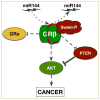Sweet-P inhibition of glucocorticoid receptor β as a potential cancer therapy
- PMID: 27468424
- PMCID: PMC4959805
Sweet-P inhibition of glucocorticoid receptor β as a potential cancer therapy
Abstract
The need for the development of new cancer therapies and push for the design of new targeting techniques is on the rise, and would be useful for cancers that are resistant to current drug treatments. The understanding of the genome has significantly advanced cancer therapy, as well as prevention and earlier detection. This research highlight discusses a potential new type of cancer-targeting molecule, Sweet-P, which is the first of its kind. Sweet-P specifically targets the microRNA-144 binding site in the 3' untranslated region (3' UTR) of the human glucocorticoid receptor β (GRβ), which has been demonstrated to increase expression. GRβ has been shown to be highly expressed in cells from solid tumors of uroepithelial carcinomas, gliomas, osteosarcomas, and hepatocellular carcinomas, as well as in liquid tumor cells from leukemia patients. In non-cancerous diseases, GRβ has been shown to be highly expressed in glucocorticoid-resistant asthma. These maladies brought the need for the development of the Sweet-P anti-GRβ molecule. Sweet-P was shown to repress the migration of bladder cancer cells, and may serve as a new therapeutic for GRβ-related diseases.
Keywords: GR; GR alpha; GR beta; Glucocorticoid receptor; Sweet-P; asthma; bladder cancer; cancer; glucocorticoids; growth; miRNA; microRNA; migration.
Conflict of interest statement
The authors have declared that no conflict of interests exist.
Figures
Similar articles
-
Glucocorticoid receptor beta increases migration of human bladder cancer cells.Oncotarget. 2016 May 10;7(19):27313-24. doi: 10.18632/oncotarget.8430. Oncotarget. 2016. PMID: 27036026 Free PMC article.
-
Glucocorticoid receptors GRα and GRβ are expressed in inflammatory dermatoses.Eur J Dermatol. 2016 Jan-Feb;26(1):21-7. doi: 10.1684/ejd.2015.2691. Eur J Dermatol. 2016. PMID: 26711698
-
Overexpression of Glucocorticoid Receptor β Enhances Myogenesis and Reduces Catabolic Gene Expression.Int J Mol Sci. 2016 Feb 11;17(2):232. doi: 10.3390/ijms17020232. Int J Mol Sci. 2016. PMID: 26875982 Free PMC article.
-
Is there a role for glucocorticoid receptor beta in asthma?Respir Res. 2001;2(1):1-4. doi: 10.1186/rr31. Epub 2000 Dec 18. Respir Res. 2001. PMID: 11686858 Free PMC article. Review.
-
Alpha and beta glucocorticoid receptors: relevance in airway diseases.Curr Allergy Asthma Rep. 2007 May;7(2):93-9. doi: 10.1007/s11882-007-0005-3. Curr Allergy Asthma Rep. 2007. PMID: 17437678 Review.
Cited by
-
Glucocorticoid Receptor β (GRβ): Beyond Its Dominant-Negative Function.Int J Mol Sci. 2021 Mar 31;22(7):3649. doi: 10.3390/ijms22073649. Int J Mol Sci. 2021. PMID: 33807481 Free PMC article. Review.
-
Glucuronidation and UGT isozymes in bladder: new targets for the treatment of uroepithelial carcinomas?Oncotarget. 2017 Jan 10;8(2):3640-3648. doi: 10.18632/oncotarget.12277. Oncotarget. 2017. PMID: 27690298 Free PMC article. Review.
-
FKBP51 and the molecular chaperoning of metabolism.Trends Endocrinol Metab. 2021 Nov;32(11):862-874. doi: 10.1016/j.tem.2021.08.003. Epub 2021 Sep 1. Trends Endocrinol Metab. 2021. PMID: 34481731 Free PMC article. Review.
-
Glucocorticoid resistance remodels liver lipids and prompts lipogenesis, eicosanoid, and inflammatory pathways.Prostaglandins Other Lipid Mediat. 2024 Aug;173:106840. doi: 10.1016/j.prostaglandins.2024.106840. Epub 2024 Jun 1. Prostaglandins Other Lipid Mediat. 2024. PMID: 38830399 Free PMC article. Review.
-
Glucocorticoid Receptor β Induces Hepatic Steatosis by Augmenting Inflammation and Inhibition of the Peroxisome Proliferator-activated Receptor (PPAR) α.J Biol Chem. 2016 Dec 9;291(50):25776-25788. doi: 10.1074/jbc.M116.752311. Epub 2016 Oct 26. J Biol Chem. 2016. PMID: 27784782 Free PMC article.
References
-
- Society AC. Cancer Facts & Figures 2015. Atlanta, Ga: American Cancer Society; 2015.
-
- Duma D, Jewell CM, Cidlowski JA. Multiple glucocorticoid receptor isoforms and mechanisms of post-translational modification. J Steroid Biochem Mol Biol. 2006:11–21. - PubMed
Grants and funding
LinkOut - more resources
Full Text Sources

